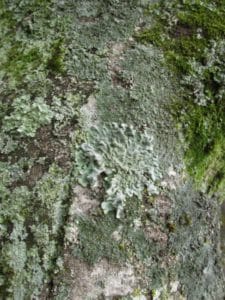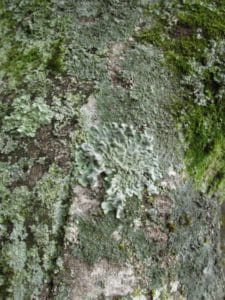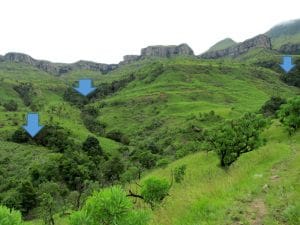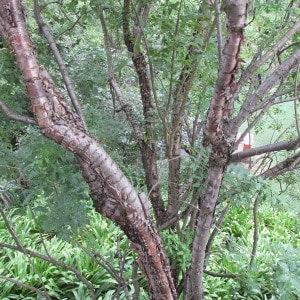
 Lichens on a tree.
Lichens on a tree.
To date, there has been almost no research on lichen biogeography, survival strategies, persistence, and the mechanics of gene flow in South Africa’s ancient Drakensberg mountain landscape. Afromont is therefore preparing to initiate a small study on mountain forest lichens on the Drakensberg escarpment – and the first impression one gains of lichen research is a strong sense of why so few people venture into lichen research!
Although prevalent, lichens seem ‘useless.’ You can’t eat them, and most of the time, lichens do not do much at all! They appear plastic, hardly alive, with a quiet metabolic and genetic complexity that is invisible. There is also the role (or non-role) of lichens in the landscape to think about. What can these organisms possibly be contributing in the grand scheme of things? From a research perspective, it is very difficult to know which species one is dealing with – they really do (almost) look the same, and so just knowing which lichenicolous fungus one is working with requires determination and some serious ‘DNA-barcoding’ types of funding and expertise. Probing their inner workings and mysteries remains the domain of an extreme inner circle of well-resourced molecular experts.
Lichen symbioses comprise a fascinating relationship between algae and fungi, and this symbiotic lifestyle evolved early in the evolution of ascomycete fungi and some basidiomycetes (Grube and Wedden, 2016). The ascomycete lichen lineages have diversified over time to give rise to a tremendous variety of morphologies and their thalli (the vegetative, non-productive body of a lichen) are often internally complex and stratified for optimized integration of algal and fungal metabolisms. Thalli are frequently colonized by specific non-lichenized fungi and occasionally also by other lichens, as well as by specific bacteria.
The Drakensberg forest patches
 Photo taken in the Central Berg near the Amphitheatre. Blue arrows indicate forest patches.
Photo taken in the Central Berg near the Amphitheatre. Blue arrows indicate forest patches.
The Drakensberg escarpment and foothills are mostly comprised of grasslands, with isolated forest patches. The Drakensberg forest patches are small, around 1-2 ha, and persist against fire, climatic change, and competition from grassland vegetation. There are thousands of such fragments on the South African side of the escarpment. The Drakensberg Afrotemperate forest fragment environment is usually on the south side of hill slopes, and is very shaded and moist, nutrient poor, and cold in winter.
A study by Adie et al (2017) shows that there are typically only a few tree species in such forest fragments, and that in general, inside the forests, the vegetation is somewhat impoverished, with about 10 species of trees and a few other shade-loving plants (Streptocarpus and Begonia species). The tree flora of Afrotemperate forests is greatly impoverished compared with lowland forests, has low levels of endemism, and displays surprising uniformity and homogeneity. In contrast, the surrounding grassland matrix is floristically rich, with high levels of endemism. Their scattered distribution, isolation, and small size raises the question of how and why these montane forests persist in this grass-dominated and fire-prone landscape (Adie et al, 2017).
Forces of isolation
 Google Earth image of the area around the Cavern Drakensberg Resort showing general grassland habitat with isolated forest patches (2017).
Google Earth image of the area around the Cavern Drakensberg Resort showing general grassland habitat with isolated forest patches (2017).
Although natural climate conditions and fire have acted to keep the forests as small patches, land use change is also rampant in the Drakensberg, completely eliminating many forest features. The Google Earth image to the right shows the dark green forest patches in a landscape that is largely grassland or over-grazed hill slopes. Gene flow between these patches would be difficult. For the trees, seeds are bird-dispersed. For lichens, we need to determine how dispersal works in local Afromontane forest landscapes.
Due to both natural and anthropogenic forces, any species or ecosystem can become isolated in the landscape. For example, in forest remnants isolated for various anthropogenic reasons, exchange of genetic material with other vegetation patches no longer occurs. This form of genetic isolation can also occur naturally over much longer periods of time. There are thousands of such isolated forest fragments on the South African Drakensberg Escarpment. How genetically isolated are the lichen populations within them, and how does genetic exchange among lichen species take place in this context? Are conditions now different from those that favoured lichen evolution and dispersal over the aeons? If lichens disperse asexually as dried fragments containing both fungi and algal components, how far do these propagules travel in the landscape (and how could one find this out?)? Are the forest patch lichens in decline, or are their populations stable? We also need to know if there is a special need to conserve conditions that favour lichens in the Drakensberg forest fragments, or if the conservation of the forest fragments is enough to ensure the persistence of the lichens.
Chemical competition
 Forest tree (species not known) with no lichen attachment.
Forest tree (species not known) with no lichen attachment.
What is noticeable in the forest fragments is that there are many different forms of tree-living lichens, as well as many individual lichens of each type, and that they seem to be able to maintain their ‘territories’ against competition by other lichens, mosses, and ferns. Also evident in the forest fragments is that there are very many types of lichens growing on trees in the forest shade, but not on all the trees. Some trees have no lichens on them at all. Lichens produce various secondary metabolites which enable them to compete for space and endure for long periods of time. Similarly, tree barks also contain chemicals that may inhibit invasions by microorganisms, fungi, and insects, and may also inhibit epiphytic lichen colonisation.
Lichens are very slow growing organisms and it makes sense that they have mechanisms with which to secure space for themselves and to prevent them from being overgrown by faster growing organisms. It was observed that different lichen species existed next to each other, but did not usually grow over each other. Also, by some mechanism, bands of lichens growing epiphytically on certain trees were not overgrown by neighbouring large mossy growths.
Future research
 Bands of lichen and moss co-existing on a tree (species not known) in a Drakensberg forest patch, December 2017.
Bands of lichen and moss co-existing on a tree (species not known) in a Drakensberg forest patch, December 2017.
In the modern molecular era, recent international work on lichens (all aspects) has greatly increased our knowledge of these organisms and the various symbiotic possibilities available to them. Using this knowledge and methodologies, it would be worthwhile asking international questions about local lichens.
Lichens are under-studied in South Africa, and their study could offer many opportunities for determined and intrepid researchers. Soberingly, biosystematics research in South Africa in general faces challenges in terms of access to experts, gaps in knowledge and capacity, and inadequate funding. For lichens in South Africa, most landscape-scale work has concentrated on species inventories and systematics, while across the rest of the world, better-resourced laboratories have probed almost every aspect of lichen biology – from their ‘pest’ value on stone monuments in Europe, to their genetics and ecological roles.
Although lichens appear to be tough survivors, we do not know how they will respond to climate change in this region, other than they have been around as a group for a long time. It would be interesting to probe the role the lichen symbiosis plays in the Drakensberg forest patches and to understand whether they are merely passive inhabitants of a very restricted, but conducive environment, or aggressively maintain their presence over long periods through various strategies and chemical means. Game on!
A resource lichen researchers should be aware of is the Recent Literature on Lichens website that includes everything published on lichens since 1536.
Also, check out: Fryday, A.M., 2015, ‘A new checklist of lichenised, lichenicolous and allied fungi reported from South Africa’, Bothalia 45(1), Art. #148, 4 pages. http://dx.doi. org/10.4102/abc.v45i1.148
References
Adie H, Kotze DJ and Lawes MJ (2017). Small fire refugia in the grassy matrix and the persistence of Afrotemperate forests in the Drakensberg Mountains. Scientific Reports.
Grube M and Wedin M (2016). Lichenized Fungi and the Evolution of Symbiotic Organization. Source: microbiolspec December 2016 vol. 4 no. 6 doi:10.1128/microbiolspec.FUNK-0011-2016

